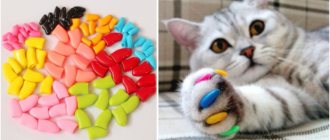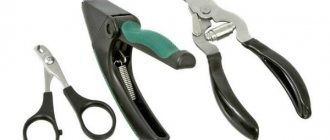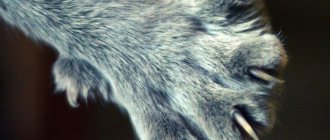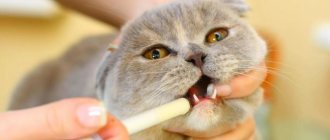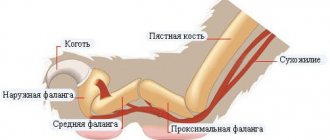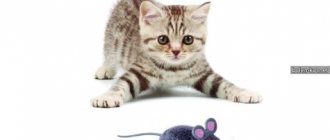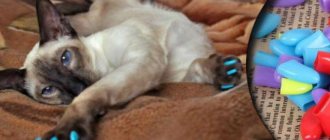American veterinarian Toby Wexler was so deeply struck by the display of inhumaneness towards cats, when their claws are removed, but in fact, their fingers are amputated, that he thought about an alternative solution to this issue.
And more than 15 years ago his invention appeared - attachments for claws. Anti-scratch products immediately became popular in America and beyond.
More on the varieties and advisability of use, as well as the advantages and disadvantages of this cat know-how.
What are silicone claw pads (anti-scratch)
Anti-scratch pads are cap-shaped covers for animal claws. The caps are made of soft, flexible silicone. The linings are also called “soft claws”. They are placed over cats' clipped claws to protect them from scratching.
anti-scratch is a device for protection against scratching
Anti-scratch pads were invented by veterinarian Toby Wexler (USA). This discovery became an alternative to onychectomy (declaw removal), as painful removal was considered the most inhumane way to protect against scratching. In civilized countries, onychectomy is prohibited, so anti-scratch treatments quickly became popular throughout the world. They come in different sizes, so they are suitable for cats aged four months and older. In addition, caps are now sold in different colors. However, anti-scratch pads are not just a fashionable device; sometimes purchasing such pads is vital. It is recommended to purchase claw pads in the following cases:
- if the animal is aggressive and rushes at guests;
- if the cat is overly playful and therefore violently attacks family members;
- if the cat is jealous and cannot come to terms with the appearance of another pet in the house (trying to “revenge” it);
- if there are small children in the house;
- if your pet has health problems (for example, with atopic dermatitis, the cat itches, scratching the skin until it bleeds).
How often should you change cat claw attachments?
It is possible that from time to time the cat will remove the anti-scratch protection itself.
If your four-legged friend sometimes tears off (loses) the pads, they can be re-glued. You cannot use the old cap; you will need to glue a new cover each time. Moreover, you don’t have to wait until all the anti-scratch pads fall off; you can add them one at a time.
Some who have never tried it before buy several sets of anti-scratch products in different colors. For example, in bags of 10 or 20 pieces. Using the entire set at one time, for “correction” you will have to open another bag. The next time you completely replace all the pads, one cap may not be enough. Therefore, it is more convenient to buy anti-scratch pads with a large number of pads of the same color, for example, 40 or 60 pieces. Or buy several packages of different colors and mix. Such methods are suitable for those people who already have an adult cat (the size of the claw will not change).
Of course, anti-scratch pads do not stick forever. The natural claw must sometimes be released, but tearing off a tightly fitting pad is painful for the animal. Therefore, you can wait until your pet's claw is updated. As the claw tissue is renewed, old cells will die off. Thus, the cap will easily come off along with the dead layer of the claw. This can happen about a month after gluing. In younger cats, this period may be shorter (about 3 weeks), but this is rare. A properly glued cap can last up to 8 weeks.
What are they for?
The point of anti-scratch for cats is to protect the owner's property: it is doubtful that anyone will like the torn furniture. Everything that the pet previously diligently tried to tear with its claws will remain intact: the cat will no longer spoil the wallpaper, door frames, tablecloths, sofas, armchairs, carpets. In a word, all things in the house will remain intact.
Those who especially often suffered from sharp cat claws can breathe easy: there will be no scratches on their hands, which serve as open gates for any infection, and a particularly zealous cat will not be able to damage children’s eyes. Cultured cat paws will protect the health of the whole family.
For people whose health is compromised, who have allergies, poor blood clotting or immunodeficiency syndrome, any scratch is dangerous. And funny silicone caps will prevent harm to the health of such a person.
So, what are the benefits of soft claws for cats :
- peace of mind for all family members: you can play with the cat without expecting a clawed trick from her;
- calmness of the pet: there are no consequences from claws - there is no reason for the owner to be angry;
- maintaining the health of all household members;
- apartment furnishings unspoiled by claws.
Thanks to Toby Wexler for his useful invention!
The benefits and harms of anti-scratch products for cats
anti-scratch products can be harmful to your pet's health
The benefits of anti-scratch pads are obvious. A cat wearing such a “manicure” will not be able to harm either things or children. Moreover, the animal will not be able to harm itself.
Every cat breeder has seen how cats itch. Some animals do this with particular frenzy. In this case, the pet can scratch its skin until it bleeds (or even tear its skin). Because of this, wounds are formed, which itch even more as they heal. They can also become infected.
In addition, some “advanced” cat owners try to purchase all kinds of devices for their pets. Instead of gray (yellowish, sometimes ugly) claws, the cat's paws will have beautiful "soft claws." But in addition to benefits, anti-scratch products can also cause harm. The pad may grow into the pad of the paw. But claws can grow in without a cap, so this is only indirect harm. You need to examine your pet's paw more often. Typically, ingrowths occur when they are not applied correctly. According to the rules, the cap should not fit to the claw all the way to the base, but with an indentation of several millimeters. You should also not put caps on untrimmed claws.
In addition, the cat can get injured (and even pull out a claw) if the pad gets stuck in something. To prevent this from happening, you need to monitor what the animal comes into contact with. For example, the cap can get stuck in grilles or cracks, or get caught in blinds or long carpet fibers. After all, a cat walking outside can get stuck in a tree or get caught on a nail. Control is especially important at first, until the cat adapts to the anti-scratch treatment.
You can choose anti-scratch protectors that match your cat's color
At first, the caps will irritate your cat and she will try to remove them with her teeth. During these attempts, the pad may be swallowed. This is undesirable, but if ingestion has occurred, then there is no need to panic. The soft anti-scratch material will not damage the walls of the esophagus, and the object, after passing through the intestines, will be released naturally. The most capricious owners may not like the clicking sound on the floor, but you can get used to the sounds.
I agree with the opinion that for cats it is always better to have their claws in a natural state and be able to use them for their intended purpose (including enjoying the point of the claws). However, situations in life are very different and it is quite possible that nail trimming or such caps will be necessary. They will not cause serious harm to the cat, but it is not very pleasant when it is impossible to cling with your claw to what you usually cling to.
Lyudmila Shiron, veterinarian
https://www.zoovet.ru/forum/?tid=18&tem=307273
Advantages
Anti-scratch products for cats have a lot of advantages. They allow pet owners to avoid many of the problems associated with living a cat in an apartment. At the same time, these devices are not dangerous for the pets themselves. Silicone claws have the following advantages:
- protect furniture, clothing, skin of children and adults, wallpaper from scratches;
- are a humane alternative to declawing;
- applicable at any age;
- harmless to cats;
- do not inhibit the natural growth of claws;
- easy to put on and take off;
- lasts up to 8 weeks;
- allow you to protect hairless cats from injuring the skin with their own paws.
Some owners who were unable to accustom their pets to caps claim that they can only be glued on for a short period of time in case of emergency. However, when used correctly, nail pads do an excellent job for up to 2 months without causing negative consequences.
Flaws
According to manufacturers, anti-scratch pads do not affect the quality of life of pets, do not hinder their movements, and allow them to jump, play, and move around in the same way as before their installation. However, not all cat owners share this opinion. Many note that the caps have several disadvantages:
- complicate natural reflex actions;
- do not allow you to stop in a timely manner after taking off;
- make it difficult to climb up hills;
- increase the frequency of cats falling when trying to climb onto a chair or sofa, leading to injury to the animals;
- do not allow pets to fully care for themselves;
- reduce the degree of claw retraction, causing discomfort to the animal;
- deprives the cat of the opportunity to defend himself on the street;
- they make an unpleasant sound when the pet walks, creaking, knocking;
- glue can cause an allergic reaction.
Advantages and disadvantages
Anti-scratch products have many advantages, which are associated not only with their low price and the abundance of colors to choose from. The advantages include the following features:
Blue anti-scratch pads
- are an alternative to amputation of the extreme phalanx of the fingers when removing claws;
- do not slow down the natural growth of claws;
- designed for different weight and age categories;
- If a cat accidentally eats the cap, it will not cause harm to its digestive system.
- save interior items;
- save children's skin from scratches;
- protect your pet's skin when he scratches himself with his hind paws;
- stick quickly and painlessly
- can be used for animals taken from the street;
- easy to wear.
Important! An aggressive or nervous cat, having anti-scratch protection, will not be able to injure the veterinarian during examination.
Also, if there are two fluffies living in the house who are conflicting with each other, then each furry fighter should be “armed” with caps.
No matter what advantages caps have, they still have disadvantages. The pads complicate the cat's actions and reflexes. With them, it is difficult for the animal to climb onto a high surface, as well as to slow down during games. As a result, falls from heights and injuries are likely.
In addition, basic hygiene procedures for a pet become difficult. The pads make it difficult to scratch, wash, or clean your ears.
Anti-scratch sets
But the most important drawback is the inability to retract the claws into the paws, which is why the animal’s fingers are constantly splayed. This causes discomfort and pain to the cat, especially at first.
Important! Spreading fingers change the cat's gait. Landing after a jump on such paws can lead to broken toes.
Overlay sizes
The anti-scratch kit includes 20 or 40 nozzles and quick-drying glue.
They vary in size:
- XS - for kittens weighing up to 1.5 kg;
- S – for cats 1.5 – 4 kg;
- M – for animals 4 – 6 kg;
- L - for representatives of large breeds from 7 kg.
Nozzles are made from silicone, rubber, soft plastic. Among them there are translucent, with glitter, and colored ones.
Duration of use
Protective accessories fall off the paws on their own as the nail plate grows. Therefore, their service life is related to the health, lifestyle and behavior of the cat. On average, the period of wearing the kit lasts from 2 to 4 weeks, and sometimes reaches 2 months.
In some cases they may be lost. The eared friend leaves them in the long pile of the carpet or chews them off.
How to choose
Before purchasing pads, evaluate the material, color, and size.
The cat is weighed to more accurately determine the size of the caps. Agree in advance with the seller about a replacement in case of a mistaken choice. If the cap falls off, the incomplete set on the paws is easier to notice with brightly colored caps that contrast with the coat color. Colored pads are easier to find on the floor and throw away; this is important when there are small children in the house.
Cats with attachments move louder; the softer the material, the less noise they make.
Anti-scratching is a necessary measure for cats that do not recognize the scratching post or behave aggressively. The pads will not cause harm if you put them on correctly, observe the cat, and if there is an adverse reaction, remove them immediately.
How to choose for different ages
Anti-scratch pads can be used from 4 months of age
If the issue with the size of the pads is resolved, you need to pay attention to other nuances. As a rule, the caps are packaged in a transparent bag (the bag may be inside the box). Review the product. The linings must be smooth, without flaws or damage. The packaging must be undamaged. Pay attention to the instructions and labels on the packaging. The manufacturer should not cause you any doubts.
When faced with a choice between an expensive, high-quality item and its budget option, the latter often wins. However, anti-scratch products are not an expensive purchase in themselves. The packaging lasts a long time, which means you can buy the more expensive option.
Anti-scratch vs surgery, scratching post and trimming
In addition to protective kits, the pet store also offers other means designed to save your home from destruction: sprays, special pheromones, which, alas, do not always work.
Another effective, but completely unacceptable for any pet, method is onychectomy - surgical removal of the claw and part of the finger. This is a very dangerous procedure that leads to dire consequences. The cat becomes disabled and cannot lead a full life and take care of itself. Many animals lose their mental health after onychectomy, which is why the operation is prohibited by law in some countries.
A scratching post becomes a solution if the cat has been trained to use it. In other cases, it simply does not work - or the pet uses both the scratching post and the owner’s favorite chair.
Trimming nails is only partially effective. Claws grow quickly, and they sharpen even faster. They have to be trimmed with a nail file all the time, and this takes a long time. Not every cat will sit for 10 minutes and endure the unpleasant procedure.
Therefore, protective kits become the best alternative. They can be used regularly, or for a short period of time - for example, during a trip, a long stay with relatives with small children, or a visit to the veterinarian.
Terms of use
Before you start working with anti-scratch products, you need to carefully study the instructions
The package can include up to 40 pads, glue and instructions. Before starting work, you should carefully study the operating instructions. If you stick the caps only on the front legs, the package will be enough for 4 times. The pads stay on the claws for up to 8 weeks. If the cat does not take them off earlier, and you put them on strictly according to the instructions, then the packaging will last for several months (up to six months) . If you make a mistake with the size, the caps can be changed at the seller or trimmed. At the time of fitting it will become clear whether there is such a need.
When not to wear caps
Anti-scratch guards are intended for domestic cats. That is, for those animals that do not end up on the street. Firstly, the owner cannot always keep track of the cat if it goes out. And there are many dangers on the street (for example, claw injury). Secondly, the animal must be able to climb to some height (if necessary).
Anti-scratch guards should also not be placed on the claws of pets prone to allergies (the cat may not tolerate glue). The original packaging comes with good quality glue, so the risk of allergies is low. But no one can guarantee the quality of the glue that comes with cheap fakes.
It is not advisable to stick caps on the claws of a sick cat
If your pet is sick, it is better not to irritate him with innovations. A weakened animal may not resist, but due to an unexpected “manicure” the cat may become stressed. This may make the condition worse.
How to stick
Before gluing the pads, you need to organize a fitting (without glue) on already trimmed nails. There is no need to trim the nails completely. It is enough to cut off the sharp corner of the claw and also treat it with a nail file on all sides. After this, the claws are degreased, for example, with alcohol (you can use acetone, but the cat may not like the pungent smell). This is necessary for better adhesion to the glue. The cap should not slip off, and its edges should be at a distance of 3–5 millimeters from the base of the claw. If this indentation is not a balloon, then the overlay can be shortened using scissors. After trying on all the caps, you can begin gluing. You need to work with glue very carefully. If there is too much of it, a drop of glue will fall on the cat's fingers, and it will hurt the cat when it moves. You can follow the following plan:
- Calm the cat (you can pet it or give it a treat) so that it is not afraid.
- Place a small amount of glue inside the cap.
- Take the cap in your right hand, and lightly press on the paw with your left so that the animal releases its claws.
- Place the cap on the desired claw (without releasing your left hand).
- Make sure that the glue does not get on the skin near the claw.
- Wait a while (5 minutes) until the glue dries.
If there is still a lot of glue, you need to wipe off the excess with a napkin. This must be done quickly so that the glue does not have time to dry. After gluing all the caps, the cat will try to rip them off, so you need to distract the cat (with food or a toy) for some time after the procedure.
How to use?
The gluing procedure is described in the step-by-step instructions for the anti-scratch pads. However, additional tips will not hurt:
- It is better to carry out the gluing procedure with an assistant.
- Immediately after applying the glue and putting the cap on the claw, it is extremely difficult to remove the anti-scratch. You need to wait until it wears off over time or falls off on its own. So try to do everything right the first time.
- Once you've filled the pad with glue , gently squeeze it to evenly distribute the glue inside.
- Your cat will pick up on your mood and feel anxious. To relieve stress from the cat (and from yourself too), in the intervals between gluing on the next cap, constantly calm the cat by talking affectionately to it and stroking its tummy and neck. This will relieve her tension.
- If the cat squirms a lot , wrap it in a towel/blanket.
- If your goal is to save furniture , then you probably only need to put caps on the front claws.
Colored Nail Caps
Understand that it may take some time for your pet to adjust to wearing anti-scratch caps.
To avoid purchasing low-quality products, buy anti-scratch products from trusted manufacturers.
When the caps are put on the cats claws, and you admire the results of your work, do not forget to take into account the following nuances:
- Check your furbaby's paws every few days to make sure the caps haven't fallen off. If one of them falls off, simply replace it.
- If for three days the cat constantly chews on the anti-scratch caps due to persistent rejection of this feline know-how, then leave it alone and do not stick new caps on its claws.
- The period of wearing the pads is from four to six weeks.
- Do not allow your pet to go outside if she is wearing silicone cat claw covers. In addition to the fact that they will wear off faster, the cat, in case of danger, will not be able to stand up for itself or climb a tree to escape its pursuer.
- If the caps are worn by a kitten , then there is no need to trim its claws.
- If you have several cats and fights happen between them, then probably all pets should wear a “cat manicure”.
How to glue
A child can put on his own socks, but a cat cannot. To ensure that the owner copes with the procedure correctly and painlessly, soft claws for cats have instructions.
Artificial claws must be worn for a long time, so first, the cat’s claws are wiped with a weak alcohol solution: this will remove dirt and grease. At the same time, this procedure serves as disinfection.
To make the claw appear, take the fluffy by the paw and knead the pad with your finger. An anti-scratch pad , selected according to the size for the cat, is applied as a fitting. The cap ideally covers only a third of the claw or the tip. The overlays can be shortened, and the claw can be trimmed perpendicular to its growth. If the owner does not know how to cut the cat’s claws, then there are detailed instructions for this too.
A third of the glue is poured into the anti-scratch pad, and the product is put on while simultaneously squeezing on all sides for 5-10 seconds.
At the end of the work, they are not in a hurry to let go of the pet - the glue will adhere better and will be ready for the cat’s attempts to rip off the innovation.
How often to change
A kitty's claws grow throughout their life, and with the renewal of the stratum corneum (once every couple of months), the silicone caps will fall off. Don't wait for them all to fall off. You can immediately glue a new anti-scratch.
For some owners, the color of the product is important - the cat is “purple”, what color the overlays are, but children will love their pet’s bright manicure.
It is important to remember that if the anti-scratch pad falls off, it must be found immediately - both children and animals can swallow the product.
How to remove from claws
In general, the wearing time of rubber pads is 1.5-2 months, so you shouldn’t bother trying to remove them - they will come off painlessly and easily on their own as soon as the new stratum corneum of the nail plate grows.
But if for some reason you need to remove the caps now and immediately, then first cut off a small tip of the product, and then use nail scissors to cut the silicone lengthwise. But you shouldn’t think that the cat will sit quietly and endure all the manipulations - it’s easier to leave the animal alone.
How to use
The first attempt to use overlays is not always successful. But this does not mean that you should give up silicone caps - you should be persistent and not give up.
Preparing animal claws
To carry out the first stickers, it is important to enlist the support of one of the family members. This will make the first attempt more successful and less traumatic.
First, you need to carefully examine the claws of your furry friend. They often differ in length, so the tip is tried on each finger separately.
A little pressure is applied to the paw pad so that the cat opens it, after which 2-3 mm of the claw is cut off with special nippers. The cut can be sharpened with a soft file, then there will be no sharp edges left.
Next, try on the overlay. It is important to make sure that it is pressed tightly and that there is 2 mm left to the base of the claw. Tips that are too long can be shortened slightly to make them easier to wear. To do this, the edges are trimmed with nail scissors.
In long-haired cats, long fur between the toes often gets in the way. In order not to stain it with glue, it is recommended to cut off any protruding hairs immediately before the procedure.
Algorithm for gluing procedure
Detailed instructions on how to glue anti-scratch pads to cats' claws are included with each kit. It is the same for protective sets of any size and color. The gluing algorithm looks like this:
- Glue is poured inside the lining, which should fill no more than half of it.
- By pressing on the pad with your fingers, you need to release the claw so that it appears at its full length.
- Step back 2 mm from the base and put on the tip, avoiding any glue getting on the fur.
- Hold for up to 10 seconds for better adhesion.
- Do not let go of your pet for 5-7 minutes so that the glue dries completely and sets.
During the procedure, the cat should experience a minimum of discomfort. Otherwise, re-sticking will not arouse positive expectations in him, and then it will be difficult to force him to this procedure.
Precautionary measures
It is more convenient and safer for the owner to use protective nails only on the front paws of the pet. This is also rational - it is with them that fluffies cause harm to surrounding objects.
The hind legs can be left alone. As a last resort, they can be filed or lightly trimmed.
During the procedure, the mustachioed friend must be securely fixed so that he cannot harm the person, run away during the procedure, or get dirty in the glue. It is better to stick the caps together: one holds, the other performs manipulations. You can’t put too much pressure on your pet, much less cause him pain.
After complete drying, watch your pet so that he does not actively chew the silicone. Distract your furry one with a treat or game.
Do not let the glue come into contact with your own hands or the cat's fur. The glue will be difficult to wash off, so it is better to use gloves or an old blanket in which you can wrap a restless animal.
Contraindications
They don’t use overlays
- Kittens will not need caps until they are 6 months old. Soft claws wear down naturally and do not cause serious damage.
- Nozzles should not be used on a cat that roams freely without supervision. The owner exposes the pet to mortal danger; wearing the pads, the cat becomes defenseless against possible opponents. The animal will not be able to defend itself with its paws and will not climb a tree to escape the dog.
- They refuse pads if they notice signs of individual intolerance to the components of the adhesive or material: redness, irritation, swelling on the pads.
- Elderly animals often stop sharpening their claws; they do not need anti-scratches.
Cats remove objects with small holes and thick pile from the access area where the nozzle can easily get stuck. The cat pulls its paw in an attempt to free itself, injuring its claw.
When not to use anti-scratch products
It is not always appropriate to use overlays. This is in such cases:
- The kitten is not yet six months old; it has soft small claws that wear off on their own during play.
- Older cats: an older animal does not show much interest in games or household items.
- Animal intolerance to artificial materials from which the product is made.
- If the cat is characteristic, he does not like innovations on himself.
- When a cat is outside, it will not be able to protect itself.
Useful video on the topic:
Price
Among Russian breeders, caps for animals are not yet very popular. However, cat lovers have increasingly become interested in where they can purchase these products and what their cost is. Anti-scratch products are an affordable product that you can buy at a pet store. They are sold even in small towns. In addition, you can order caps through online stores.
The price of such devices is low. One package costs on average from 300 to 400 rubles. The cost of false claws depends on the quality of the materials used, the manufacturer and the pricing policy of a particular pet store. The kit may include 40 or 20 nozzles, special glue and instructions. One package can last for several months or even years, since the attachments are often replaced not on all claws, but only on 1 or 2. The glue is suitable for use for two years. Considering these factors, anti-scratch devices can be called a budget invention.
Sources
- https://prohvost.club/koshki/uhod-za-koshkami/nakladki-na-kogti-dlya-koshek.html
- https://101kote.ru/stati/antitsarapki-dlya-koshek.html
- https://MurKoshka.ru/uhod/anticarapki-dlya-koshek.html
- https://koshek.ru/nakladki-dlya-kogtej-dlya-koshek.html
[collapse]
What do veterinarians say?
There are no clear reviews among veterinarians about anti-scratch products for cats. But most doctors tend to recommend them for their mustachioed patients.
Common Myths
Despite the fact that manufacturers insist that silicone claws are completely safe for the health of your mustachioed friend, there are quite a lot of myths about their use. Here are the most common reasons why owners do not want to purchase the “soft paws” accessory:
- The claws itch underneath. This is incorrect because there are no nerve endings on the nail plate.
- They interfere with retracting the claws. In fact, everything is attached to the tip, which sticks out of the pad.
- The animal's gait changes greatly. This is true, but not for all cats and for a very short period of time.
- The material and glue are toxic. Manufacturers and veterinarians say this is not true. Even ingestion cannot harm your pet.
To make use as comfortable as possible, it is necessary to follow the order of gluing them. In addition, when choosing silicone kits at a pet store, it is important to carefully read their composition and instructions.
